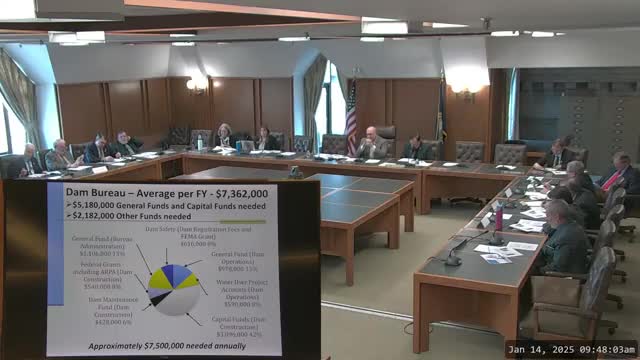ISO New England tells committee electrification will shift peak demand toward winter; transmission and long‑duration resources required
January 14, 2025 | Science, Technology and Energy, House of Representatives, Committees , Legislative, New Hampshire
This article was created by AI summarizing key points discussed. AI makes mistakes, so for full details and context, please refer to the video of the full meeting. Please report any errors so we can fix them. Report an error »

ISO New England representatives briefed the committee on real‑time operations, market responsibilities and long‑term transmission planning. “Our mission is to plan the transmission system, administer wholesale markets, and operate the bulk power system, in real time,” Executive Director Eric Johnson told the committee.
Five core roles. ISO staff explained their role as operator, market administrator and planner, regulated by the Federal Energy Regulatory Commission and responsible for reliability coordination under NERC. The ISO said it does not own generation or fuel supply assets but needs to model fuel availability and transmission capability when assessing future reliability.
Resource mix and the interconnection queue. The ISO described New England’s 2023 resource mix as heavily reliant on natural gas today but noted rapid growth in solar, wind and battery storage in the interconnection queue. Nathan Rake said batteries and wind constitute large shares of that queue, though he cautioned that developer intent and permitting realities will shape how much of that capacity is built.
Peak timing and electrification. ISO modeling for a 2050 transmission study shows a strong shift if transportation and building systems electrify: peak demand could double in some scenarios and shift from a summer to a winter peak, requiring new transmission and more dispatchable or long‑duration flexibility resources.
Transmission and planning. The ISO explained a new, longer‑term planning authority to assess transmission for 2050 goals; the ISO is coordinating with the New England States Committee on Electricity (NESCO) and will issue requests for proposals for transmission that aligns with state energy visions.
Operational impacts of solar. The ISO demonstrated how behind‑the‑meter solar reduces midday demand on the bulk system and creates a steep evening ramp when solar output falls, describing operational challenges for dispatchable resources that must follow rapid changes in net load.
Why it matters for New Hampshire. ISO staff told the committee that while most resource decisions are driven by state policy and private developers, the region‑wide shift toward renewables will require new transmission and new operational practices. The ISO urged lawmakers to consider the timing and scale of state climate goals, long‑lead times for transmission build, and the tradeoffs among reliability, cost and emissions.
Ending. ISO officials invited the committee to tour their control center and offered follow‑up materials — including modeling summaries and the 2050 transmission study — to support legislative review and utility planning.
Five core roles. ISO staff explained their role as operator, market administrator and planner, regulated by the Federal Energy Regulatory Commission and responsible for reliability coordination under NERC. The ISO said it does not own generation or fuel supply assets but needs to model fuel availability and transmission capability when assessing future reliability.
Resource mix and the interconnection queue. The ISO described New England’s 2023 resource mix as heavily reliant on natural gas today but noted rapid growth in solar, wind and battery storage in the interconnection queue. Nathan Rake said batteries and wind constitute large shares of that queue, though he cautioned that developer intent and permitting realities will shape how much of that capacity is built.
Peak timing and electrification. ISO modeling for a 2050 transmission study shows a strong shift if transportation and building systems electrify: peak demand could double in some scenarios and shift from a summer to a winter peak, requiring new transmission and more dispatchable or long‑duration flexibility resources.
Transmission and planning. The ISO explained a new, longer‑term planning authority to assess transmission for 2050 goals; the ISO is coordinating with the New England States Committee on Electricity (NESCO) and will issue requests for proposals for transmission that aligns with state energy visions.
Operational impacts of solar. The ISO demonstrated how behind‑the‑meter solar reduces midday demand on the bulk system and creates a steep evening ramp when solar output falls, describing operational challenges for dispatchable resources that must follow rapid changes in net load.
Why it matters for New Hampshire. ISO staff told the committee that while most resource decisions are driven by state policy and private developers, the region‑wide shift toward renewables will require new transmission and new operational practices. The ISO urged lawmakers to consider the timing and scale of state climate goals, long‑lead times for transmission build, and the tradeoffs among reliability, cost and emissions.
Ending. ISO officials invited the committee to tour their control center and offered follow‑up materials — including modeling summaries and the 2050 transmission study — to support legislative review and utility planning.
View full meeting
This article is based on a recent meeting—watch the full video and explore the complete transcript for deeper insights into the discussion.
View full meeting
